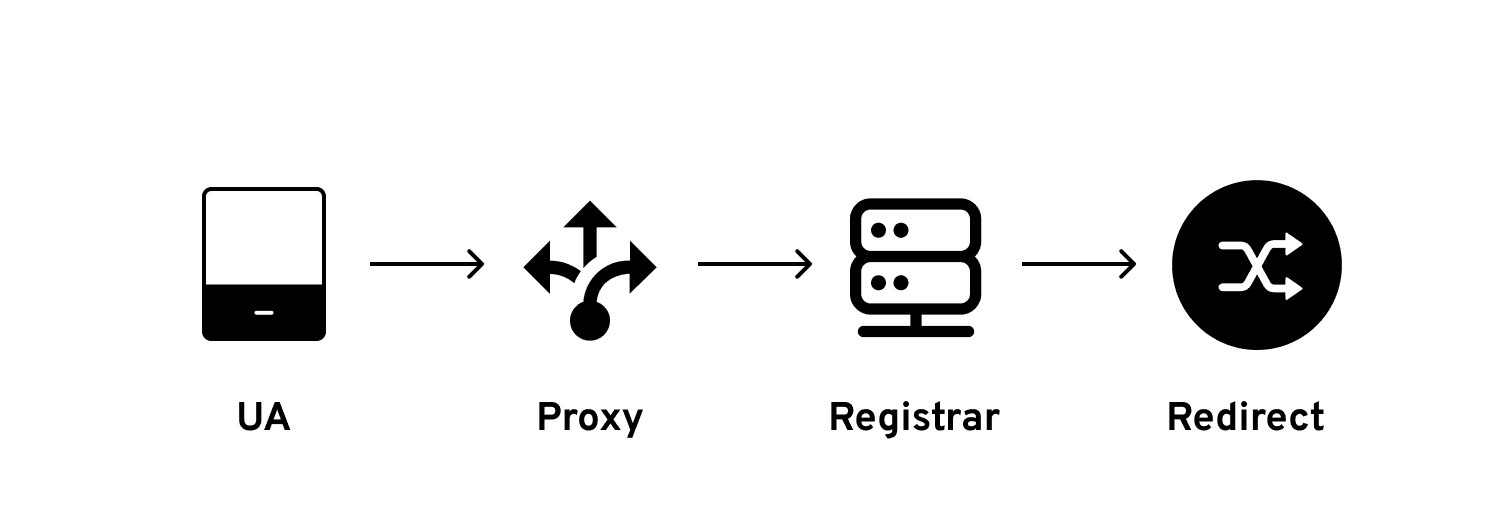What is SIP: The Role of Session Initiation Protocol in Real-Time Communication
SIP (Session Initiation Protocol) is a signaling protocol used to control the establishment, modification, and termination of multimedia communication sessions. It supports various communication methods, including voice, video, and instant messaging, and is widely used in internet telephony and enterprise communication systems. With its flexibility and scalability, SIP plays a central role in modern communication technology, enabling users to interact in real-time over IP networks and promoting the proliferation and development of multimedia communication.

What is SIP?
SIP (Session Initiation Protocol) is an application layer signaling control protocol used to create, modify, and terminate sessions involving one or more participants. These sessions can include Internet multimedia conferences, IP telephony, or multimedia distribution. SIP supports functions such as user location discovery, session establishment, and session management.
SIP was initially proposed by Henning Schulzrinne and Mark Handley in 1996 and later became a standard of the IETF (Internet Engineering Task Force) in 1999 (RFC 2543). As an important VoIP (Voice over Internet Protocol) protocol, SIP is widely used in internet telephony, video conferencing systems, and instant messaging.
As a communication protocol operating at the OSI application layer, SIP provides robust support for establishing, modifying, and terminating multimedia sessions. Its flexibility, scalability, and simplicity make it a vital component of internet communication. By integrating with other protocols, SIP plays a significant role in voice calls, video conferencing, and instant messaging. With the continuous development of internet communication, the SIP protocol will continue to play an important role, providing users with a more convenient and high-quality communication experience.
How Does SIP Work?
SIP operates based on a request/response model, similar to HTTP. It uses a client/server architecture, where the User Agent (UA) initiates requests, and servers (such as proxy servers, registration servers, and redirect servers) handle these requests. SIP messages consist of headers and an optional message body, with the headers containing details about the session, such as call ID, timestamps, and media types.
Key components or steps:
- User Agent (UA): The terminal device that initiates and receives SIP requests, such as an IP phone or softphone.
- Proxy Server: Receives requests and routes them to the next server or user agent.
- Registration Server: Manages user registration information to know the user's current location.
- Session Description Protocol (SDP): Used in SIP messages to describe the parameters of the media session, such as codecs, bandwidth, and IP addresses.

In this simplified flowchart, the UA first sends a registration request to the registration server through the proxy server. Once the registration server confirms, the UA can initiate a call request via the proxy server, which routes the request to the target UA based on the registration information.
You can think of SIP as the operator of a telephone system. When you want to call someone, you (UA) ask the operator (proxy server) for the other person's phone number (registration information), and then the operator connects the call for you (routes the request). If the other party is unavailable, the operator may inform you of the other party's possible new number (redirection). Throughout the call, the operator is also responsible for managing the connection and quality of the call (session management).
Application Scenarios of SIP
SIP protocol is primarily applied in the field of multimedia communication, including real-time communication, call control, and telephone system construction. It can be used to facilitate voice, video, and messaging communication between different terminal devices. Additionally, SIP is widely used in VoIP (Voice over Internet Protocol) systems, enterprise communication systems, multimedia conferencing, and instant messaging services.
Specific use case examples:
- Real-time Communication: The SIP protocol can be used to establish voice calls or video conferences between different terminal devices, enabling real-time communication.
- Call Control: The SIP protocol can be utilized for call control and management, such as routing calls to target terminal devices or terminating calls.
- Telephone Systems: The SIP protocol can be used to build telephone systems, including routing incoming calls to IP phones or traditional telephone networks, as well as implementing features like voicemail and call forwarding.
- Enterprise Communication: In enterprises, the SIP protocol can be used to establish internal communication networks, enabling instant messaging, voice, and video calls among employees.
Advantages and Benefits of SIP
Compared to traditional telephone systems (PRI), SIP trunking excels in flexibility and scalability, while PRI outperforms in reliability, voice quality, and compatibility with existing telephone systems. SIP transmits data over the internet, resulting in lower long-distance call costs compared to traditional phone lines, and it is not limited by geographical boundaries. In comparison to H.323 and WebRTC, SIP is known for its high scalability, capable of handling a large number of simultaneous calls, making it ideal for organizations and service providers with a growing user base. Additionally, WebRTC offers built-in security features, including media and data encryption, while SIP requires additional security measures.
SIP's online presence facilitates a more efficient and collaborative communication model. It not only helps merge enterprise communication with contact center operations but also integrates the enterprise ecosystem by conveying online status through a standard mechanism, allowing the entire organization's resources to be utilized by the contact center. By leveraging the advantages of SIP trunking, businesses can streamline communication, reduce costs, and enhance productivity. Its cost-effectiveness, scalability, and flexibility make it an ideal choice for enterprises looking to modernize their communication methods. As an open, internet-centric communication standard, SIP will fundamentally change the scope of call routing in contact centers, enabling everyone within the enterprise and its partner and supplier ecosystem to become a resource for the contact center.
Challenges and Limitations of SIP
SIP phones require a certain amount of network bandwidth and traffic; insufficient bandwidth or excessive traffic may lead to a decline in communication quality or interruptions. The SIP protocol may also be restricted by network firewalls and security policies, which can affect the stability and quality of communication. As the SIP protocol is updated and upgraded, compatibility between devices and software may be impacted, resulting in communication failures or degraded quality. Additionally, SIP phone systems face security threats from IP network attacks and attacks on SIP phone terminals, necessitating extra security measures and encryption technologies to protect the security and privacy of the communication process.
SIP implementation also faces some potential issues, such as interoperability problems. There may be interoperability issues between SIP products from different vendors, which can lead to communication difficulties. NAT (Network Address Translation) and firewalls can hinder the transmission of SIP signaling and media streams. Providing stable and high-quality voice and video communication services over the public internet is also a challenge.
Some operators may impose restrictions on the use of SIP phones or adopt specific policies that affect network stability and communication quality. Additionally, due to the open nature of the SIP protocol, there is a risk of being attacked, necessitating more security measures to protect user privacy. As technology evolves, the SIP protocol and related technologies need to be continuously updated and upgraded to maintain compatibility and security.
Conclusion
In conclusion, SIP stands out as a versatile and scalable communication protocol that is pivotal in the realm of multimedia communication. By enabling real-time interactions and unified communication solutions, SIP not only reduces costs and enhances efficiency but also paves the way for the modernization of enterprise communication. As businesses continue to evolve, SIP will remain a cornerstone technology, driving innovation and fostering seamless communication in an increasingly interconnected world.
TRTC (Tencent Real-Time Communication) is a high-performance real-time audio and video solution designed to provide users with a smooth, low-latency communication experience. The main features of TRTC include high-definition audio and video calls, multi-person conferences, and real-time interactive live streaming, supporting various terminal devices to ensure users can enjoy high-quality communication services in different environments. Its advantages lie in its strong network adaptability, which automatically adjusts audio and video quality based on network conditions, ensuring a stable connection under various network circumstances. Additionally, TRTC offers a rich set of SDKs and APIs, making it easy for developers to quickly integrate real-time communication features into their applications, enhancing user experience. Through an efficient technical architecture and flexible application scenarios, TRTC provides a reliable real-time communication solution for both enterprises and individual users.
If you have any questions or need assistance, our support team is always ready to help. Please feel free to Contact Us or join us in Telegram.
FAQs
Q1: What is SIP?
A1: SIP stands for Session Initiation Protocol, which is a signaling protocol used to initiate, maintain, and terminate real-time communication sessions such as voice and video calls over the Internet.
Q2: How does SIP work?
A2: SIP works by sending messages between endpoints to establish a session, manage its parameters, and eventually terminate it when the communication is complete.
Q3: What are the main components of SIP?
A3: The main components of SIP include user agents (clients and servers), proxies, and registrars, which work together to facilitate communication.
Q4: Is SIP secure?
A4: SIP can be secured using protocols like Transport Layer Security (TLS) for signaling and Secure Real-time Transport Protocol (SRTP) for media encryption, ensuring privacy and integrity.
Q5: What applications use SIP?
A5: SIP is widely used in Voice over IP (VoIP) services, video conferencing, instant messaging, and other multimedia communication applications.

